Russian vs Cypriot Community Comparison
COMPARE
Russian
Cypriot
Social Comparison
Social Comparison
Russians
Cypriots
8,595
SOCIAL INDEX
83.4/ 100
SOCIAL RATING
62nd/ 347
SOCIAL RANK
8,674
SOCIAL INDEX
84.2/ 100
SOCIAL RATING
58th/ 347
SOCIAL RANK
Cypriot Integration in Russian Communities
The statistical analysis conducted on geographies consisting of 61,658,669 people shows a substantial positive correlation between the proportion of Cypriots within Russian communities in the United States with a correlation coefficient (R) of 0.552. On average, for every 1% (one percent) increase in Russians within a typical geography, there is an increase of 0.010% in Cypriots. To illustrate, in a geography comprising of 100,000 individuals, a rise of 1,000 Russians corresponds to an increase of 10.1 Cypriots.
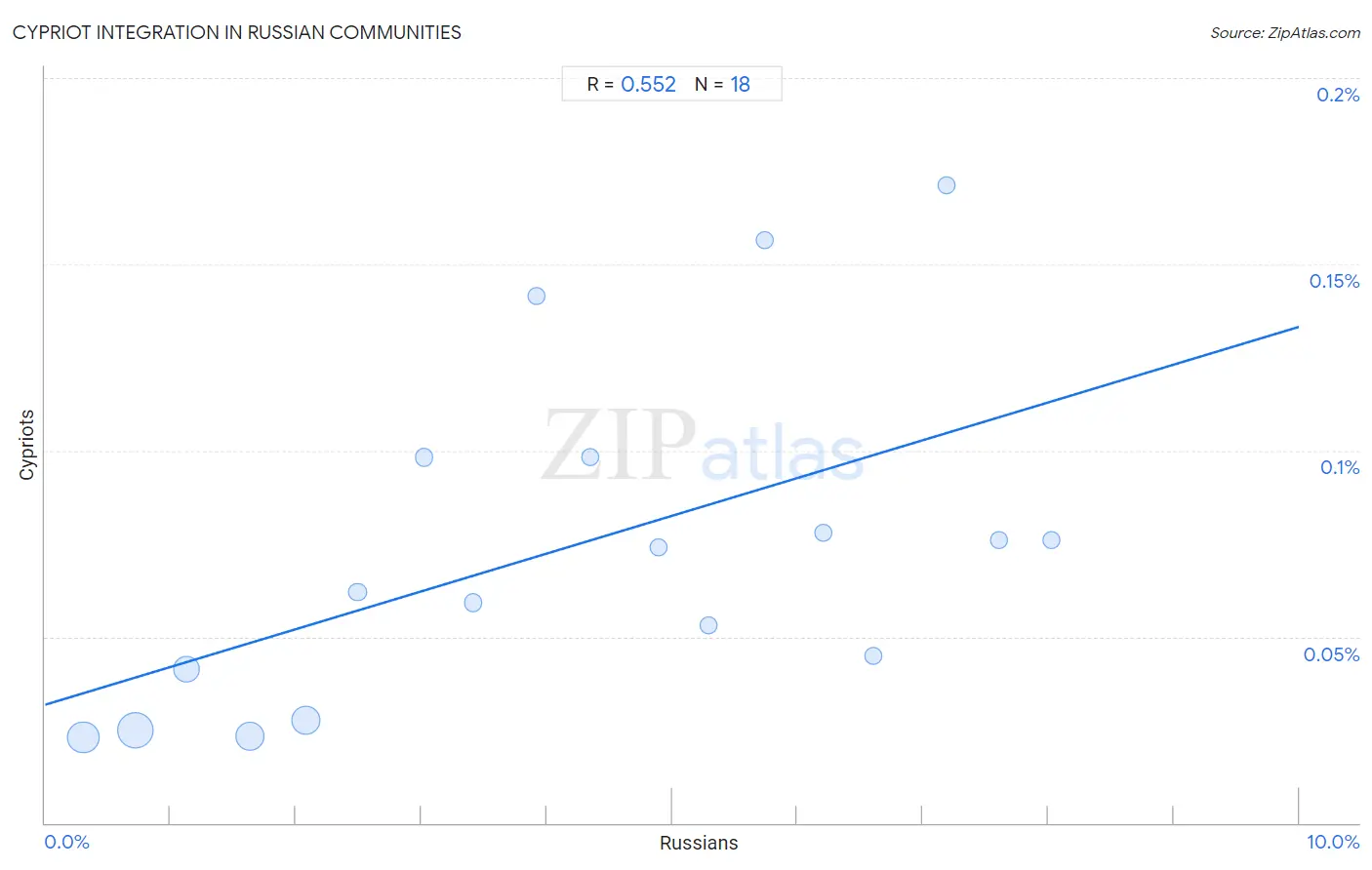
Russian vs Cypriot Income
When considering income, the most significant differences between Russian and Cypriot communities in the United States are seen in householder income ages 45 - 64 years ($116,328 compared to $123,396, a difference of 6.1%), householder income over 65 years ($67,626 compared to $71,714, a difference of 6.0%), and median family income ($120,487 compared to $127,064, a difference of 5.5%). Conversely, both communities are more comparable in terms of median earnings ($53,334 compared to $54,589, a difference of 2.4%), median male earnings ($63,939 compared to $65,549, a difference of 2.5%), and wage/income gap (28.0% compared to 27.3%, a difference of 2.7%).

| Income Metric | Russian | Cypriot |
| Per Capita Income | Exceptional $53,154 | Exceptional $54,899 |
| Median Family Income | Exceptional $120,487 | Exceptional $127,064 |
| Median Household Income | Exceptional $98,008 | Exceptional $102,843 |
| Median Earnings | Exceptional $53,334 | Exceptional $54,589 |
| Median Male Earnings | Exceptional $63,939 | Exceptional $65,549 |
| Median Female Earnings | Exceptional $44,169 | Exceptional $45,570 |
| Householder Age | Under 25 years | Exceptional $54,389 | Average $52,209 |
| Householder Age | 25 - 44 years | Exceptional $110,398 | Exceptional $116,364 |
| Householder Age | 45 - 64 years | Exceptional $116,328 | Exceptional $123,396 |
| Householder Age | Over 65 years | Exceptional $67,626 | Exceptional $71,714 |
| Wage/Income Gap | Tragic 28.0% | Tragic 27.3% |
Russian vs Cypriot Poverty
When considering poverty, the most significant differences between Russian and Cypriot communities in the United States are seen in receiving food stamps (9.6% compared to 8.9%, a difference of 8.7%), single male poverty (12.5% compared to 11.7%, a difference of 6.7%), and child poverty under the age of 5 (14.8% compared to 14.0%, a difference of 5.7%). Conversely, both communities are more comparable in terms of male poverty (9.9% compared to 9.9%, a difference of 0.080%), single female poverty (19.2% compared to 19.2%, a difference of 0.23%), and poverty (10.9% compared to 10.8%, a difference of 0.27%).
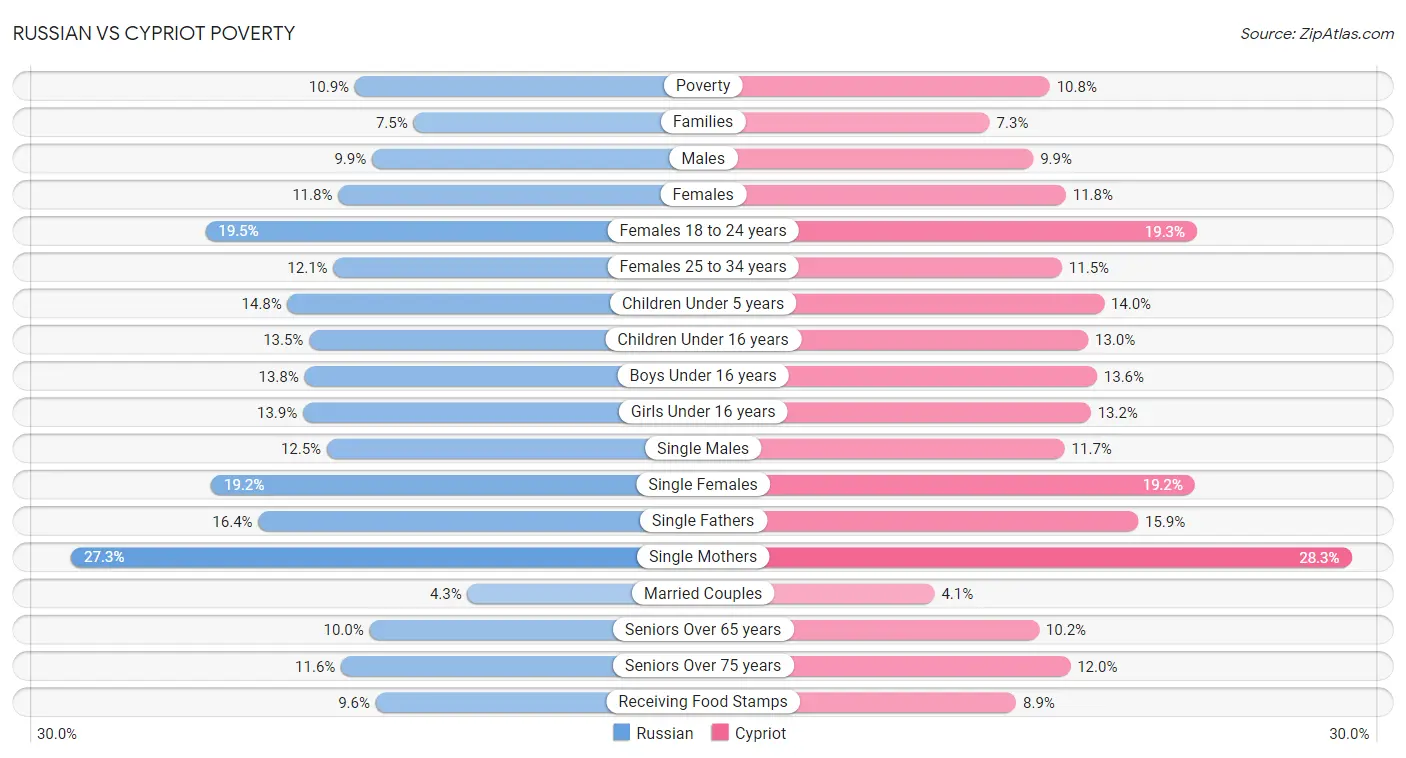
| Poverty Metric | Russian | Cypriot |
| Poverty | Exceptional 10.9% | Exceptional 10.8% |
| Families | Exceptional 7.5% | Exceptional 7.3% |
| Males | Exceptional 9.9% | Exceptional 9.9% |
| Females | Exceptional 11.8% | Exceptional 11.8% |
| Females 18 to 24 years | Exceptional 19.5% | Exceptional 19.3% |
| Females 25 to 34 years | Exceptional 12.1% | Exceptional 11.5% |
| Children Under 5 years | Exceptional 14.8% | Exceptional 14.0% |
| Children Under 16 years | Exceptional 13.5% | Exceptional 13.0% |
| Boys Under 16 years | Exceptional 13.8% | Exceptional 13.6% |
| Girls Under 16 years | Exceptional 13.9% | Exceptional 13.2% |
| Single Males | Excellent 12.5% | Exceptional 11.7% |
| Single Females | Exceptional 19.2% | Exceptional 19.2% |
| Single Fathers | Fair 16.4% | Excellent 15.9% |
| Single Mothers | Exceptional 27.3% | Exceptional 28.3% |
| Married Couples | Exceptional 4.3% | Exceptional 4.1% |
| Seniors Over 65 years | Exceptional 10.0% | Exceptional 10.2% |
| Seniors Over 75 years | Excellent 11.6% | Good 12.0% |
| Receiving Food Stamps | Exceptional 9.6% | Exceptional 8.9% |
Russian vs Cypriot Unemployment
When considering unemployment, the most significant differences between Russian and Cypriot communities in the United States are seen in unemployment among seniors over 75 years (8.9% compared to 7.4%, a difference of 20.0%), unemployment among ages 16 to 19 years (17.6% compared to 19.6%, a difference of 11.4%), and unemployment among women with children under 6 years (7.2% compared to 6.5%, a difference of 9.9%). Conversely, both communities are more comparable in terms of unemployment among ages 20 to 24 years (10.4% compared to 10.4%, a difference of 0.13%), unemployment (5.0% compared to 4.9%, a difference of 0.34%), and male unemployment (5.1% compared to 5.1%, a difference of 0.76%).
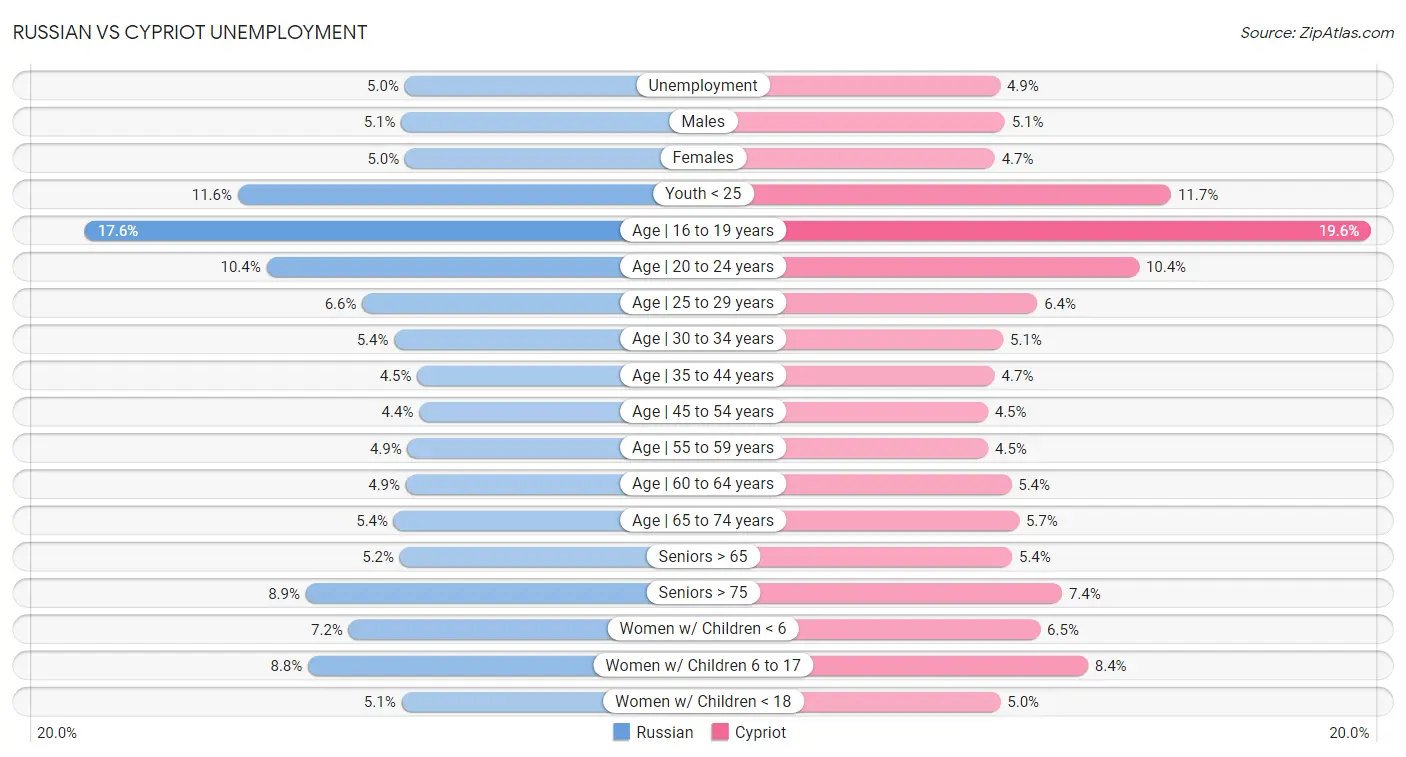
| Unemployment Metric | Russian | Cypriot |
| Unemployment | Exceptional 5.0% | Exceptional 4.9% |
| Males | Exceptional 5.1% | Excellent 5.1% |
| Females | Exceptional 5.0% | Exceptional 4.7% |
| Youth < 25 | Average 11.6% | Fair 11.7% |
| Age | 16 to 19 years | Average 17.6% | Tragic 19.6% |
| Age | 20 to 24 years | Fair 10.4% | Poor 10.4% |
| Age | 25 to 29 years | Average 6.6% | Exceptional 6.4% |
| Age | 30 to 34 years | Good 5.4% | Exceptional 5.1% |
| Age | 35 to 44 years | Exceptional 4.5% | Fair 4.7% |
| Age | 45 to 54 years | Exceptional 4.4% | Good 4.5% |
| Age | 55 to 59 years | Fair 4.9% | Exceptional 4.5% |
| Age | 60 to 64 years | Poor 4.9% | Tragic 5.4% |
| Age | 65 to 74 years | Fair 5.4% | Tragic 5.7% |
| Seniors > 65 | Average 5.2% | Tragic 5.4% |
| Seniors > 75 | Fair 8.9% | Exceptional 7.4% |
| Women w/ Children < 6 | Exceptional 7.2% | Exceptional 6.5% |
| Women w/ Children 6 to 17 | Excellent 8.8% | Exceptional 8.4% |
| Women w/ Children < 18 | Exceptional 5.1% | Exceptional 5.0% |
Russian vs Cypriot Labor Participation
When considering labor participation, the most significant differences between Russian and Cypriot communities in the United States are seen in in labor force | age 16-19 (36.7% compared to 33.8%, a difference of 8.5%), in labor force | age 20-24 (74.8% compared to 73.3%, a difference of 2.1%), and in labor force | age > 16 (64.9% compared to 65.5%, a difference of 0.98%). Conversely, both communities are more comparable in terms of in labor force | age 20-64 (80.0% compared to 80.2%, a difference of 0.19%), in labor force | age 35-44 (85.0% compared to 85.2%, a difference of 0.24%), and in labor force | age 30-34 (85.5% compared to 85.8%, a difference of 0.35%).

| Labor Participation Metric | Russian | Cypriot |
| In Labor Force | Age > 16 | Poor 64.9% | Excellent 65.5% |
| In Labor Force | Age 20-64 | Exceptional 80.0% | Exceptional 80.2% |
| In Labor Force | Age 16-19 | Average 36.7% | Tragic 33.8% |
| In Labor Force | Age 20-24 | Fair 74.8% | Tragic 73.3% |
| In Labor Force | Age 25-29 | Exceptional 85.3% | Exceptional 85.8% |
| In Labor Force | Age 30-34 | Exceptional 85.5% | Exceptional 85.8% |
| In Labor Force | Age 35-44 | Exceptional 85.0% | Exceptional 85.2% |
| In Labor Force | Age 45-54 | Exceptional 83.4% | Exceptional 84.1% |
Russian vs Cypriot Family Structure
When considering family structure, the most significant differences between Russian and Cypriot communities in the United States are seen in divorced or separated (11.5% compared to 10.5%, a difference of 9.9%), single father households (2.0% compared to 1.8%, a difference of 8.9%), and single mother households (5.3% compared to 5.1%, a difference of 4.2%). Conversely, both communities are more comparable in terms of family households (63.4% compared to 63.2%, a difference of 0.30%), married-couple households (48.2% compared to 48.0%, a difference of 0.37%), and average family size (3.12 compared to 3.14, a difference of 0.55%).

| Family Structure Metric | Russian | Cypriot |
| Family Households | Tragic 63.4% | Tragic 63.2% |
| Family Households with Children | Tragic 26.5% | Tragic 25.9% |
| Married-couple Households | Exceptional 48.2% | Exceptional 48.0% |
| Average Family Size | Tragic 3.12 | Tragic 3.14 |
| Single Father Households | Exceptional 2.0% | Exceptional 1.8% |
| Single Mother Households | Exceptional 5.3% | Exceptional 5.1% |
| Currently Married | Exceptional 48.6% | Exceptional 47.8% |
| Divorced or Separated | Exceptional 11.5% | Exceptional 10.5% |
| Births to Unmarried Women | Exceptional 28.0% | Exceptional 27.0% |
Russian vs Cypriot Vehicle Availability
When considering vehicle availability, the most significant differences between Russian and Cypriot communities in the United States are seen in no vehicles in household (11.6% compared to 15.7%, a difference of 35.0%), 4 or more vehicles in household (6.0% compared to 5.0%, a difference of 19.0%), and 3 or more vehicles in household (18.8% compared to 16.6%, a difference of 13.3%). Conversely, both communities are more comparable in terms of 1 or more vehicles in household (88.7% compared to 84.4%, a difference of 5.1%), 2 or more vehicles in household (54.8% compared to 50.6%, a difference of 8.4%), and 3 or more vehicles in household (18.8% compared to 16.6%, a difference of 13.3%).

| Vehicle Availability Metric | Russian | Cypriot |
| No Vehicles Available | Tragic 11.6% | Tragic 15.7% |
| 1+ Vehicles Available | Tragic 88.7% | Tragic 84.4% |
| 2+ Vehicles Available | Fair 54.8% | Tragic 50.6% |
| 3+ Vehicles Available | Poor 18.8% | Tragic 16.6% |
| 4+ Vehicles Available | Poor 6.0% | Tragic 5.0% |
Russian vs Cypriot Education Level
When considering education level, the most significant differences between Russian and Cypriot communities in the United States are seen in master's degree (19.5% compared to 21.8%, a difference of 11.5%), professional degree (6.3% compared to 6.9%, a difference of 9.6%), and bachelor's degree (45.3% compared to 49.0%, a difference of 8.2%). Conversely, both communities are more comparable in terms of high school diploma (91.5% compared to 91.5%, a difference of 0.010%), 12th grade, no diploma (93.2% compared to 93.1%, a difference of 0.020%), and nursery school (98.4% compared to 98.3%, a difference of 0.11%).
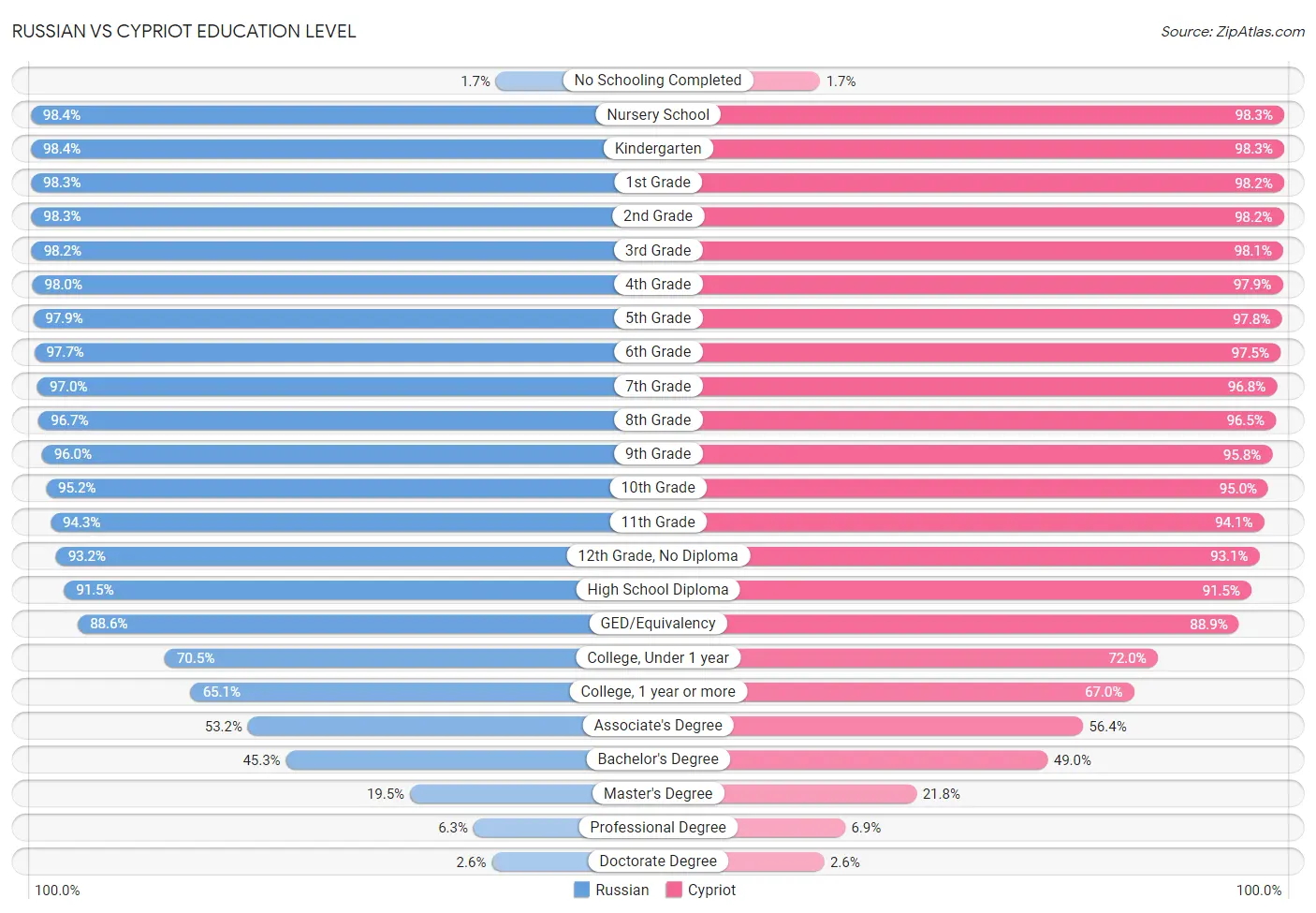
| Education Level Metric | Russian | Cypriot |
| No Schooling Completed | Exceptional 1.7% | Exceptional 1.7% |
| Nursery School | Exceptional 98.4% | Exceptional 98.3% |
| Kindergarten | Exceptional 98.4% | Exceptional 98.3% |
| 1st Grade | Exceptional 98.3% | Exceptional 98.2% |
| 2nd Grade | Exceptional 98.3% | Exceptional 98.2% |
| 3rd Grade | Exceptional 98.2% | Exceptional 98.1% |
| 4th Grade | Exceptional 98.0% | Exceptional 97.9% |
| 5th Grade | Exceptional 97.9% | Exceptional 97.8% |
| 6th Grade | Exceptional 97.7% | Exceptional 97.5% |
| 7th Grade | Exceptional 97.0% | Exceptional 96.8% |
| 8th Grade | Exceptional 96.7% | Exceptional 96.5% |
| 9th Grade | Exceptional 96.0% | Exceptional 95.8% |
| 10th Grade | Exceptional 95.2% | Exceptional 95.0% |
| 11th Grade | Exceptional 94.3% | Exceptional 94.1% |
| 12th Grade, No Diploma | Exceptional 93.2% | Exceptional 93.1% |
| High School Diploma | Exceptional 91.5% | Exceptional 91.5% |
| GED/Equivalency | Exceptional 88.6% | Exceptional 88.9% |
| College, Under 1 year | Exceptional 70.5% | Exceptional 72.0% |
| College, 1 year or more | Exceptional 65.1% | Exceptional 67.0% |
| Associate's Degree | Exceptional 53.2% | Exceptional 56.4% |
| Bachelor's Degree | Exceptional 45.3% | Exceptional 49.0% |
| Master's Degree | Exceptional 19.5% | Exceptional 21.8% |
| Professional Degree | Exceptional 6.3% | Exceptional 6.9% |
| Doctorate Degree | Exceptional 2.6% | Exceptional 2.6% |
Russian vs Cypriot Disability
When considering disability, the most significant differences between Russian and Cypriot communities in the United States are seen in hearing disability (3.2% compared to 2.8%, a difference of 12.8%), male disability (11.1% compared to 10.0%, a difference of 10.7%), and disability age 35 to 64 (10.2% compared to 9.4%, a difference of 8.7%). Conversely, both communities are more comparable in terms of disability age 5 to 17 (5.3% compared to 5.3%, a difference of 0.32%), vision disability (2.0% compared to 2.0%, a difference of 2.8%), and cognitive disability (16.4% compared to 17.1%, a difference of 3.9%).
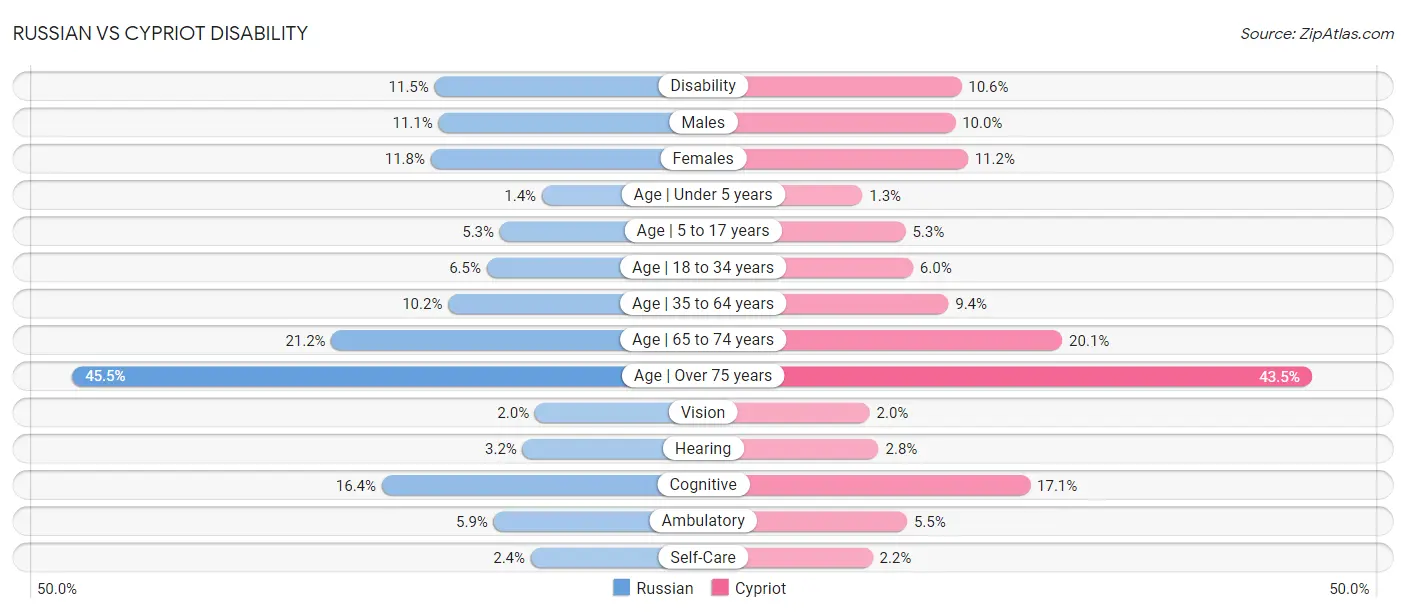
| Disability Metric | Russian | Cypriot |
| Disability | Excellent 11.5% | Exceptional 10.6% |
| Males | Good 11.1% | Exceptional 10.0% |
| Females | Exceptional 11.8% | Exceptional 11.2% |
| Age | Under 5 years | Tragic 1.4% | Poor 1.3% |
| Age | 5 to 17 years | Exceptional 5.3% | Exceptional 5.3% |
| Age | 18 to 34 years | Good 6.5% | Exceptional 6.0% |
| Age | 35 to 64 years | Exceptional 10.2% | Exceptional 9.4% |
| Age | 65 to 74 years | Exceptional 21.2% | Exceptional 20.1% |
| Age | Over 75 years | Exceptional 45.5% | Exceptional 43.5% |
| Vision | Exceptional 2.0% | Exceptional 2.0% |
| Hearing | Tragic 3.2% | Exceptional 2.8% |
| Cognitive | Exceptional 16.4% | Excellent 17.1% |
| Ambulatory | Exceptional 5.9% | Exceptional 5.5% |
| Self-Care | Excellent 2.4% | Exceptional 2.2% |